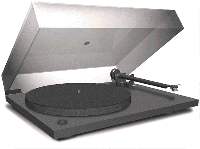
Today vinyl is produced in large quantities and sold all over the world. Today's records (and indeed, today's record decks) bear little resemblance to their ancestors. This site only scratches the surface of the chemistry and history of this most enduring musical medium.
The most important other constituent in records is vinyl acetate, which copolymerizes the vinyl chloride, to achieve the correct properties for records (your average 12" being obviously quite different to your average drainpipe). Carbon black is added to give the records their colour and stabilizing agents may also be mixed in.
Some discs are produced using 're-grind'. This involves grinding up and re-using spillage and bad pressings, or even old records. However this lowers the quality of the vinyl produced and therefore 'virgin vinyl' is preferred for quality pressings. This section contains three subsections: Polyvinyl Chloride, Other constituents & Past records